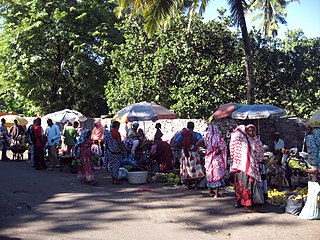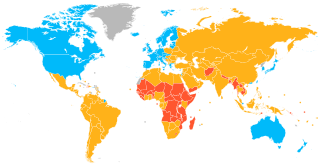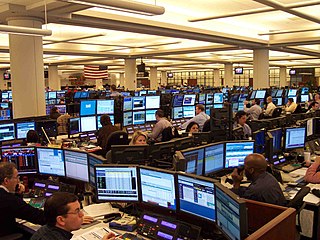
The economy of Tanzania is a lower-middle income economy that is overwhelmingly dependent on agriculture. Tanzania's economy has been transitioning from a command economy to a market economy since 1985. Although total GDP has increased since these reforms began, GDP per capita dropped sharply at first, and only exceeded the pre-transition figure in around 2007.

The United Nations Conference on Trade and Development (UNCTAD) is an intergovernmental organization within the United Nations Secretariat that promotes the interests of developing countries in world trade. It was established in 1964 by the United Nations General Assembly (UNGA) and reports to that body and the United Nations Economic and Social Council (ECOSOC). UNCTAD is composed of 195 member states and works with nongovernmental organizations worldwide; its permanent secretariat is in Geneva, Switzerland.

The economy of the Comoros is based on subsistence agriculture and fishing. Comoros has inadequate transportation links, a young and rapidly increasing population, and few natural resources. The low educational level of the labor force contributes to a subsistence level of economic activity, high unemployment, and a heavy dependence on foreign grants and technical assistance. The Comoros, with an estimated gross domestic product (GDP) per capita income of about $700, is among the world's poorest and least developed nations. Although the quality of the land differs from island to island, most of the widespread lava-encrusted soil formations are unsuited to agriculture. As a result, most of the inhabitants make their living from subsistence agriculture and fishing. Average wages in 2007 hover around $3–4 per day.

An agricultural subsidy is a government incentive paid to agribusinesses, agricultural organizations and farms to supplement their income, manage the supply of agricultural commodities, and influence the cost and supply of such commodities.
In economics, the Prebisch–Singer hypothesis argues that the price of primary commodities declines relative to the price of manufactured goods over the long term, which causes the terms of trade of primary-product-based economies to deteriorate. As of 2013, recent statistical studies have given support for the idea. The idea was developed by Raúl Prebisch and Hans Singer in the late 1940s; since that time, it has served as a major pillar of dependency theory and policies such as import substitution industrialization (ISI).

The concept of Global North and Global South is used to describe a grouping of countries along the lines of socio-economic and political characteristics. The Global South is a term that broadly comprises countries in the regions of Africa, Latin America and the Caribbean, Asia, and Oceania, according to the United Nations Conference on Trade and Development (UNCTAD). Most of the countries in the Global South are characterized by low income, dense population, poor infrastructure, and often political or cultural marginalization. The Global South forms one side of the divide; on the other is the Global North. As such, the terms Global North and Global South do not refer to the cardinal directions of north and south as many of the Global South countries are geographically located in the Northern Hemisphere.

Non-tariff barriers to trade are trade barriers that restrict imports or exports of goods or services through mechanisms other than the simple imposition of tariffs. Such barriers are subject to controversy and debate, as they may comply with international rules on trade yet serve protectionist purposes.
Dependency theory is the idea that resources flow from a "periphery" of poor and underdeveloped states to a "core" of wealthy states, enriching the latter at the expense of the former. A central contention of dependency theory is that poor states are impoverished and rich ones enriched by the way poor states are integrated into the "world system". This theory was officially developed in the late 1960s following World War II, as scholars searched for the root issue in the lack of development in Latin America.
Trade can be a key factor in economic development. The prudent use of trade can boost a country's development and create absolute gains for the trading partners involved. Trade has been touted as an important tool in the path to development by prominent economists. However trade may not be a panacea for development as important questions surrounding how free trade really is and the harm trade can cause domestic infant industries to come into play.
The resource curse, also known as the paradox of plenty or the poverty paradox, is the phenomenon of countries with an abundance of natural resources having less economic growth, less democracy, or worse development outcomes than countries with fewer natural resources. There are many theories and much academic debate about the reasons for and exceptions to the adverse outcomes. Most experts believe the resource curse is not universal or inevitable but affects certain types of countries or regions under certain conditions.
The New International Economic Order (NIEO) is a set of proposals advocated by developing countries to end economic colonialism and dependency through a new interdependent economy. The main NIEO document recognized that the current international economic order "was established at a time when most of the developing countries did not even exist as independent states and which perpetuates inequality." In the spirit of "trade not aid," the NIEO called for changes in trade, industrialization, agricultural production, finance, and transfer of technology. The United Nations General Assembly adopted the Declaration for the Establishment of a New International Economic Order and its accompanying program of action on 1 May 1974.
The landlocked developing countries (LLDC) are developing countries that are landlocked. The economic and other disadvantages experienced by such countries makes the majority of landlocked countries the least developed countries (LDCs), with inhabitants of these countries occupying the bottom billion tier of the world's population in terms of poverty. Outside of Europe, there is not a single highly developed landlocked country as measured by the Human Development Index (HDI), and nine of the twelve countries with the lowest HDI scores are landlocked. Landlocked European countries are exceptions in terms of development outcomes due to their close integration with the regional European market. Landlocked countries that rely on transoceanic trade usually suffer a cost of trade that is double that of their maritime neighbours. Landlocked countries experience economic growth 6% less than non-landlocked countries, holding other variables constant.
The Agreement on Agriculture (AoA) is an international treaty of the World Trade Organization. It was negotiated during the Uruguay Round of the General Agreement on Tariffs and Trade, and entered into force with the establishment of the WTO on January 1, 1995.

The economy of the Middle East is very diverse, with national economies ranging from hydrocarbon-exporting rentiers to centralized socialist economies and free-market economies. The region is best known for oil production and export, which significantly impacts the entire region through the wealth it generates and through labor utilization. In recent years, many of the countries in the region have undertaken efforts to diversify their economies.

The price of oil, or the oil price, generally refers to the spot price of a barrel of benchmark crude oil—a reference price for buyers and sellers of crude oil such as West Texas Intermediate (WTI), Brent Crude, Dubai Crude, OPEC Reference Basket, Tapis crude, Bonny Light, Urals oil, Isthmus, and Western Canadian Select (WCS). Oil prices are determined by global supply and demand, rather than any country's domestic production level.

Coffee is a popular beverage and an important commodity. Tens of millions of small producers in developing countries make their living growing coffee. Over 2.25 billion cups of coffee are consumed in the world daily. Over 90 percent of coffee production takes place in developing countries — mainly South America — while consumption happens primarily in industrialized economies. There are 25 million small producers who rely on coffee for a living worldwide. In Brazil, where almost a third of the world's coffee is produced, over five million people are employed in the cultivation and harvesting of over three billion coffee plants; it is a more labor-intensive culture than alternative cultures of the same regions, such as sugar cane or cattle, as its cultivation is not automated, requiring frequent human attention.

The world food price crisis refers to a period of time when the cost of food increased significantly and had a profound impact on the availability and affordability of food for people around the world. This crisis is often characterized by sharp spikes in the prices of key staple foods such as wheat, rice, and corn, as well as other agricultural commodities such as sugar and oil. The causes of the world food price crisis are complex and multifaceted, but they generally involve a combination of factors including droughts and other weather-related events, increased demand for biofuels, trade policies, and financial speculation. The consequences of the world food price crisis can be severe, particularly for people in low-income countries who spend a large portion of their income on food. According to IMF if prices eventually rise again, there will likely be sizeable differences between countries. Due to various factors, it is probable that the effect would be felt most by consumers in emerging markets and developing economies still wrestling with the effects of the pandemic.
In the agricultural context, diversification can be regarded as the re-allocation of some of a farm's productive resources, such as land, capital, farm equipment and labour to other products and, particularly in richer countries, to non-farming activities such as restaurants and shops. Factors leading to decisions to diversify are many, but include: reducing risk, responding to changing consumer demands or changing government policy, responding to external shocks and, more recently, as a consequence of climate change.

Food prices refer to the average price level for food across countries, regions and on a global scale. Food prices affect producers and consumers of food.

Sustainable Development Goal 2 aims to achieve "zero hunger". It is one of the 17 Sustainable Development Goals established by the United Nations in 2015. The official wording is: "End hunger, achieve food security and improved nutrition and promote sustainable agriculture". SDG 2 highlights the "complex inter-linkages between food security, nutrition, rural transformation and sustainable agriculture". According to the United Nations, there are around 690 million people who are hungry, which accounts for slightly less than 10 percent of the world population. One in every nine people goes to bed hungry each night, including 20 million people currently at risk of famine in South Sudan, Somalia, Yemen and Nigeria.













